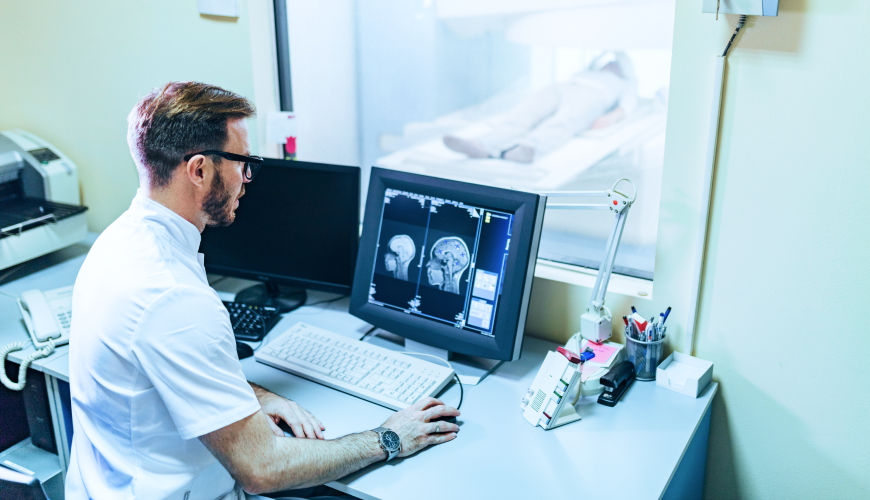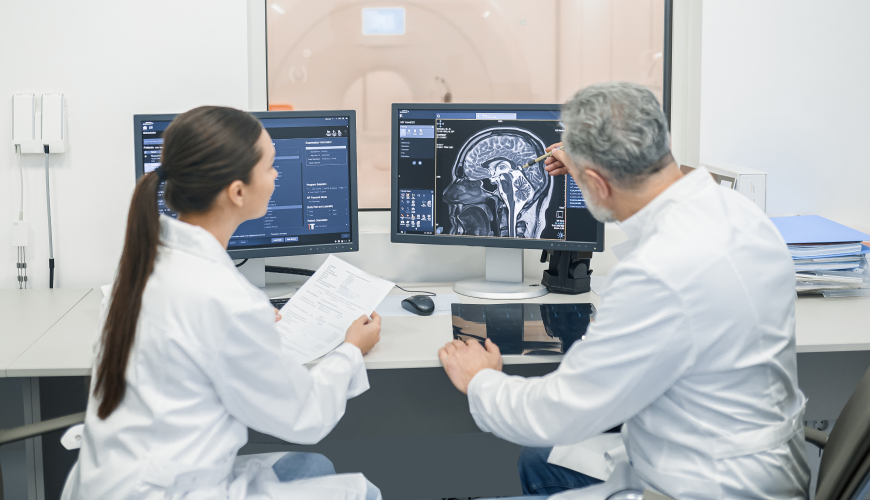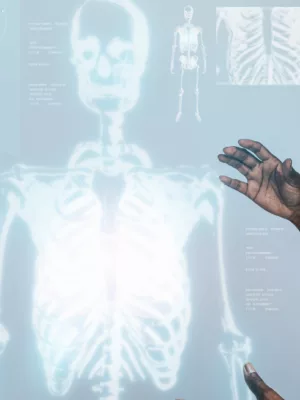
What if doctors could improve their ability to diagnose and treat patients while saving valuable time? Or determine if a patient needs surgery or immediate hospitalization quickly and efficiently? It’s all possible by combining artificial intelligence (AI) with medical imaging software. This is the future of healthcare. AI won’t replace doctors, but it will change their work.
We expect to see AI in healthcare skyrocket in the next few years. A case in point is the advancements made to implement AI into medical imaging modalities.
Medical images make up over 90% of all medical data. They have helped diagnose cancer, neurological disorders, and gynecological and cardiovascular conditions. With specialized software in this area to automatically interpret medical images, medical practitioners can use MRIs, CT scans, echocardiography scans, and ultrasounds more effectively.
2D scans have even evolved into high-resolution 3D models of different body systems and organs in a real-time visual representation. As a result of this trend, medical imaging procedures are being used to guide intervention, control therapy, and monitor the cause of illnesses.
Besides improvements in hardware and devices, software for managing medical images has made significant progress as well. According to the Statista forecast, medical image analysis software will exceed $4.2 billion by 2025.
We already know doctors work hard. But this technology will allow them to work smarter.
Analyzing patients’ images takes a lot of time. With the shortage of radiologists and aging medical imaging equipment, a proactive approach has never been greater to reduce the bottleneck of radiology tasks and patient traffic.
Let's look at how medical image analysis tools can benefit hospitals, health facilities and practitioners. Additionally, we'll discuss key elements of medical image analysis software development.
The benefits of medical image analysis software
There are several ways in which medical image analysis software can assist in organizing and interpreting data:
- Meet high demand for medical images: Radiologists can access patient data quickly and securely, identify possible deviations from the norm, and automate scheduling/follow-up workflows. These factors will process each image much faster, allowing radiologists to increase patient traffic significantly.
- Scale and operate efficiently: Traditionally, healthcare facilities manually stored medical images for patients. Once medical records piled up, they became increasingly hard to manage, which took a lot of the staff’s time and opened the door to security breaches. Using medical imaging software to streamline the data storage process can ensure that the data transfers securely and quickly.
- Secure data storage: Easy access to a patient's data would mean nothing if it wasn't safe. Most modern medical imaging solutions are PIPEDA/HIPAA-compliant. You’re responsible for ensuring the confidentiality of patient data, preventing data theft, protecting against attempted data disclosures, and restricting access to authorized individuals.
- Quickly track treatment process: Most medical image analysis software databases store data and images of each patient chronologically. As a patient progresses through treatment, their radiologist can easily pull their information from their past and compare the different states of the patient’s treatment.
- Allows non-radiology medical professionals to interpret image data: Other physicians cannot analyze data without radiology help in image processing. This slows down the workflow. AI and predictive image analysis has made it easier for medical practitioners to analyze and interpret the data and provide actionable insights to patients without the need to consult radiologists directly.
With these above capabilities, healthcare professionals can:
- Reduce routine paperwork
- Facilitate a management process that’s smooth and efficient
- Provide an efficient treatment due to early diagnosis
- Improve communication with other healthcare workers
- Access data in real-time
- Automate day-to-day tasks
- Reduce manual errors
What healthcare departments can get value from AI-powered medical image analysis software?
Over the years, we have seen more healthcare institutions transform how they deliver healthcare through AI, primarily in medical imaging. Here are some healthcare departments using this new technology to provide better care to more people by improving productivity.
Cardiology
In 2021, cardiology accounted for 20% of the radiology image analysis software market, which makes sense considering cardiovascular disease is Canada's second leading cause of death. Advanced algorithms are used in various stages of cardiovascular image analysis.
A recent example is Cleerly Proxy, a software that automates the upload of CT angiograms from local systems to Cleerly's cloud service. The pre-hardened virtual machine can be installed and set up in minutes, saving time and reducing security risks for each Cleerly heart analysis. It also allows clinicians to enhance the speed and accuracy of identifying atherosclerosis (thickening or hardening of the arteries).
Dentistry
Image-based decision-making is a challenge in dentistry because the oral cavity contains many tiny, overlapped structures. Add to that the various sizes, shapes and positions of teeth, and analysis becomes difficult. Medical image analysis software allows dentists to improve diagnosis accuracy and workflow and can detect tooth decay and bone diseases like osteoporosis. The software can also be used when designing orthodontic appliances and dental prostheses.
Take, for example, 3Dme Crown, an automatic crown design module. Based on the patient's 3D scan data, using AI technology, the crown prosthesis design is generated in seconds to suit the patient's oral environment and sent to a 3D printer or milling machine for immediate prosthesis production. Dental clinics and labs can produce crown prostheses within a shorter timeframe, which used to take several days. It also reduces the number of patient visits and increases satisfaction with treatment.
Neurology
In brain imaging, AI algorithms can help clinicians spot subtle brain abnormalities that are otherwise invisible. Take epilepsy, for example, which affects 70 million people worldwide. For one-third of people with epilepsy, their seizures don't respond to current medications, and clinicians cannot predict which drugs will work in which patients.
Canadian epilepsy researchers in a clinical study trained a machine learning model to analyze epilepsy patients’ brain scans that don't reveal any visible signs of the condition in an MRI scan. As a result, the solution helped the researchers locate the source of seizures in two women and were crucial in planning surgeries.
Breast oncology
In 2022, 28,600 Canadian women will be diagnosed with breast cancer, with 25% being a new diagnosis. As a result, tumour detection is significant in breast imaging.
A new study published in The Lancet Digital Health shows that radiologists assisted by AI screen for breast cancer more successfully than when they work alone. The same AI software also delivers better results when operated by radiologists than on its own.
Features of AI and medical image analysis software
While traditional medical imaging continues to meet the needs of healthcare environments, it can be more effective with AI-driven features, including:
- Improvements to image quality
- Image segmentation
- Integrate images from multiple scenes
- Image quantification
- 2D visualization and 3D reconstruction
Challenges of custom medical image analysis software development
Medical imaging and processing software come with challenges. You must pay attention to these challenges to use modern technologies to their full potential. Here are a few of them:
- Security and compliance: In medical imaging, personal information about patients is collected and protected by PIPEDA/HIPAA. Penalties can reach millions of dollars, so compliance is imperative. As you build your tech stack, ensure you include all the necessary standards and anonymize your data once it leaves your premises.
- Training AI models: Algorithmic models can only do what you teach them. Because of this, choose only relevant algorithms and use correct, high-quality data to train them. If not, the results will be inaccurate.
- Collecting training data: Developing clinical decision-making software without large data sets is impossible. So, before the development process begins, ensure you know exactly how you'll gather and prepare your training data and if you have secure storage space available.
Entrust your medical imaging software to a reliable vendor
The custom healthcare software market is booming. It's no surprise, as digitalization brings many advantages to healthcare organizations, health workers, and patients.
As a software developer, Convergine helps healthcare organizations take advantage of technology and gain a competitive edge. By combining our expertise in the healthcare industry with our ability to customize a solution to fit the needs of each client, we make sure that we constantly improve our development process.
If you want to make the most of digital innovations, get in touch with our team today to learn how custom image analysis software development can benefit your business.








